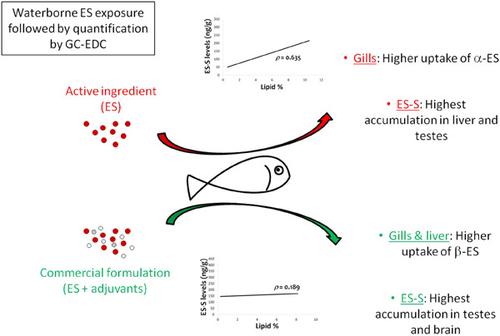当前位置:
X-MOL 学术
›
Environ. Toxicol. Chem.
›
论文详情
Our official English website, www.x-mol.net, welcomes your
feedback! (Note: you will need to create a separate account there.)
Bioaccumulation and Distribution Behavior of Endosulfan on a Cichlid Fish: Differences Between Exposure to the Active Ingredient and a Commercial Formulation.
Environmental Toxicology and Chemistry ( IF 3.6 ) Pub Date : 2020-01-28 , DOI: 10.1002/etc.4643 Rodrigo Hérnan Da Cuña 1, 2 , Fabiana Laura Lo Nostro 1, 2 , Valeria Shimabukuro 3 , Paola Mariana Ondarza 3 , Karina Silvia Beatriz Miglioranza 3
Environmental Toxicology and Chemistry ( IF 3.6 ) Pub Date : 2020-01-28 , DOI: 10.1002/etc.4643 Rodrigo Hérnan Da Cuña 1, 2 , Fabiana Laura Lo Nostro 1, 2 , Valeria Shimabukuro 3 , Paola Mariana Ondarza 3 , Karina Silvia Beatriz Miglioranza 3
Affiliation

|
Persistent organic pollutants reach aquatic ecosystems during application and can bioconcentrate/biomagnify because of their lipophilic nature. Toxicological studies focus almost exclusively on the active ingredients of pesticides, instead of commercial formulations, whose toxicity can differ as a result of nonspecified ingredients. The intensive use of endosulfan as a wide-ranging insecticide over the last few decades makes it one of the most frequently detected contaminants in the aquatic environment, even after it has been restricted worldwide. The aim of the present study was to evaluate the bioaccumulation and organ distribution of waterborne endosulfan in the freshwater fish Cichlasoma dimerus, comparing the active ingredient and a commercial formulation. Males were exposed to 0.7 μg/L endosulfan for 2 wk, which was quantified (gas chromatography with an electron capture detector) in the liver, testes, gills, brain, and muscle. The results suggest rapid metabolism of α-endosulfan and β-endosulfan isomers to endosulfan sulfate (endosulfan-S) in tissues. Isomer levels were highest in gills, indicative of recent uptake. Levels of endosulfan-S were highest in liver and testes for the active ingredient and testes and brain for the commercial formulation. For the active ingredient, endosulfan-S levels showed a positive correlation with organ-lipid percentage. No correlation was evident for the commercial formulation, indicating that the presence of adjuvants alters endosulfan distribution because gills and liver showed a higher uptake and mobilization of β-endosulfan. These differences in organ distribution may alter tissue-specific toxicity; therefore, additives cannot be considered inactive even if nontoxic. Environ Toxicol Chem 2020;39:604-611. © 2019 SETAC.
中文翻译:

硫丹在丽鱼科鱼上的生物蓄积和分布行为:暴露于活性成分和商业配方之间的差异。
持久性有机污染物在使用过程中会进入水生生态系统,并且由于其亲脂性而可以生物富集/生物放大。毒理学研究几乎完全集中于农药的活性成分,而不是商业制剂,其商业毒性可能因未指定成分而有所不同。在过去的几十年中,硫丹被广泛用作广泛的杀虫剂,即使在全世界范围内,硫丹仍是水生环境中最常被检测到的污染物之一。本研究的目的是评估淡水鱼长白刺鱼中水基硫丹的生物积累和器官分布,并比较其有效成分和商业配方。雄性暴露于0.7μg/ L硫丹2周,在肝脏,睾丸,腮,大脑和肌肉中进行了定量(气相色谱仪和电子捕获检测器)。结果表明,组织中α-硫丹和β-硫丹的异构体迅速代谢为硫丹硫酸盐(endosulfan-S)。g中的异构体水平最高,表明近期有摄入。肝脏和睾丸中的活性成分含量最高,硫丹-S的含量最高;市售制剂中的硫丹含量最高。对于活性成分,硫丹-S水平与器官脂质百分比呈正相关。商业制剂没有明显的相关性,表明佐剂的存在改变了硫丹的分布,因为g和肝脏显示出更高的β-硫丹吸收和动员能力。这些器官分布的差异可能会改变组织特异性毒性。所以,即使无毒,添加剂也不能视为无活性。Environ Toxicol Chem 2020; 39:604-611。©2019 SETAC。
更新日期:2020-02-27
中文翻译:

硫丹在丽鱼科鱼上的生物蓄积和分布行为:暴露于活性成分和商业配方之间的差异。
持久性有机污染物在使用过程中会进入水生生态系统,并且由于其亲脂性而可以生物富集/生物放大。毒理学研究几乎完全集中于农药的活性成分,而不是商业制剂,其商业毒性可能因未指定成分而有所不同。在过去的几十年中,硫丹被广泛用作广泛的杀虫剂,即使在全世界范围内,硫丹仍是水生环境中最常被检测到的污染物之一。本研究的目的是评估淡水鱼长白刺鱼中水基硫丹的生物积累和器官分布,并比较其有效成分和商业配方。雄性暴露于0.7μg/ L硫丹2周,在肝脏,睾丸,腮,大脑和肌肉中进行了定量(气相色谱仪和电子捕获检测器)。结果表明,组织中α-硫丹和β-硫丹的异构体迅速代谢为硫丹硫酸盐(endosulfan-S)。g中的异构体水平最高,表明近期有摄入。肝脏和睾丸中的活性成分含量最高,硫丹-S的含量最高;市售制剂中的硫丹含量最高。对于活性成分,硫丹-S水平与器官脂质百分比呈正相关。商业制剂没有明显的相关性,表明佐剂的存在改变了硫丹的分布,因为g和肝脏显示出更高的β-硫丹吸收和动员能力。这些器官分布的差异可能会改变组织特异性毒性。所以,即使无毒,添加剂也不能视为无活性。Environ Toxicol Chem 2020; 39:604-611。©2019 SETAC。











































 京公网安备 11010802027423号
京公网安备 11010802027423号